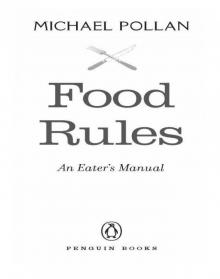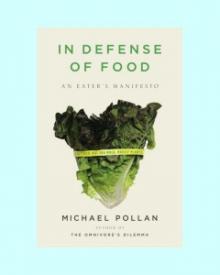- Home
- Michael Pollan
In Defense of Food Page 5
In Defense of Food Read online
Page 5
By the end of the review, there is one strong association between a type of dietary fat and heart disease left standing, and it happens to be precisely the type of fat that the low-fat campaigners have spent most of the last thirty years encouraging us to consume more of: trans fats. It turns out that “a higher intake of trans fat can contribute to increased risk of CHD through multiple mechanisms”; to wit, it raises bad cholesterol and lowers good cholesterol (something not even the evil saturated fats can do); it increases triglycerides, a risk factor for CHD; it promotes inflammation and possibly thrombogenesis (clotting), and it may promote insulin resistance. Trans fat is really bad stuff, apparently, fully twice as bad as saturated fat in its impact on cholesterol ratios. If any of the authors of the critical review are conscious of the cosmic irony here-that the principal contribution of thirty years of official nutritional advice has been to replace a possibly mildly unhealthy fat in our diets with a demonstrably lethal one-they are not saying.
The paper is not quite prepared to throw out the entire lipid hypothesis, but by the end precious little of it is left standing. The authors conclude that while total levels of fat in the diet apparently have little bearing on the risk of heart disease (!), the ratio between types of fats does. Adding omega-3 fatty acids to the diet (that is, eating more of a certain kind of fat) “substantially reduces coronary and total mortality” in heart patients, and replacing saturated fats with polyunsaturated fats lowers blood cholesterol, which they deem an important risk factor for CHD. (Some researchers no longer do, pointing out that half the people who get heart attacks don’t have elevated cholesterol levels, and about half the people with elevated cholesterol do not suffer from CHD.) One other little grenade is dropped in the paper’s conclusion: Although “a major purported benefit of a low-fat diet is weight loss,” a review of the literature failed to turn up any convincing evidence of this proposition. To the contrary, it found “some evidence” that replacing fats in the diet with carbohydrates (as official dietary advice has urged us to do since the 1970s) will lead to weight gain.
I have dwelled on this paper because it fairly reflects the current thinking on the increasingly tenuous links between dietary fat and health. The lipid hypothesis is quietly melting away, but no one in the public health community, or the government, seems quite ready to publicly acknowledge it. For fear of what exactly? That we’ll binge on bacon double cheeseburgers? More likely that we’ll come to the unavoidable conclusion that the emperors of nutrition have no clothes and never listen to them again.
In fact, there have been dissenters to the lipid hypothesis all along, lipid biochemists like Mary Enig (who has been sounding the alarm on trans fats since the 1970s) and nutritionists like Fred Kummerow and John Yudkin (who have been sounding the alarm on refined carbohydrates, also since the 1970s), but these critics have always had trouble getting a hearing, especially after 1977, when the McGovern guidelines effectively closed off debate on the lipid hypothesis.
Scientific paradigms are never easy to challenge, even when they begin to crack under the weight of contradictory evidence. Few scientists ever look back to see where they and their paradigms might have gone astray; rather, they’re trained to keep moving forward, doing yet more science to add to the increments of our knowledge, patching up and preserving whatever of the current consensus can be preserved until the next big idea comes along. So don’t count on a scientific Aleksandr Solzhenitsyn to show up and expose the whole fat paradigm as a historical disaster.
The closest thing to such a figure we have had is not a scientist but a science journalist named Gary Taubes, who for the last decade has been blowing the whistle on the science behind the low-fat campaign. In a devastating series of articles and an important new book called Good Calories, Bad Calories, Taubes has all but demolished the whole lipid hypothesis, demonstrating just how little scientific backing it had from the very beginning.
Indeed. Wind the tape back to 1976, and you find plenty of reasons to doubt the lipid hypothesis even then. Some of these reasons were circumstantial, but nevertheless compelling. For instance, during the decades of the twentieth century when rates of heart disease were rising in America, Americans were actually reducing their intake of animal fats (in the form of lard and tallow). In place of those fats, they consumed substantially more vegetable oils, especially in the form of margarine, sales of which outpaced butter for the first time in 1957. Between the end of World War II and 1976 (the year of McGovern’s hearings), per capita consumption of animal fats from all sources dropped from eighty-four pounds to seventy-one, while fats from seed oils approximately doubled. Americans appeared to be moving in the direction of a “prudent diet” and yet, paradoxically, having more heart attacks on it, not fewer.*
As for the precipitous decline in heart disease during the years of World War II, that could just as easily be attributed to factors other than the scarcity of meat, butter, and eggs. Not just animal protein, but sugar and gasoline were also strictly rationed during the war. Americans generally ate less of everything, including, notably, refined carbohydrates; they did, however, eat more fish. And got more exercise because they couldn’t drive as freely thanks to gas rationing.
But the lipid hypothesis would not be deterred. Researchers in the 1950s and 1960s had studied populations in other countries that had substantially lower rates of heart disease, which could be explained by their lower consumption of saturated fat. That it could just as easily be explained by other factors-fewer total calories? fewer refined carbohydrates? more exercise? more fruits and vegetables or fish?-did not disturb the gathering consensus that fat must be the key.
The consensus hinged on two suggestive links that were well established by the early sixties: a link between high rates of cholesterol in the blood and the likelihood of heart disease and a link between saturated fat in the diet and cholesterol levels in the blood. Both these links have held up, but it doesn’t necessarily follow from them that consumption of saturated fat leads to heart disease, unless you can also demonstrate that serum cholesterol is a cause of heart disease and not, say, just a symptom of it. And though evidence for a link between cholesterol in the diet and cholesterol in the blood has always been tenuous, the belief that the former contributed to the latter has persisted, perhaps because it makes such intuitive sense-and perhaps because it has been so heavily promoted by the margarine makers.
&nbs
p; Despite these gaps, it seemed a short easy step for McGovern’s committee to link the links, as it were, and conclude that eating meat and dairy (as important sources of both saturated fat and cholesterol) contributed to heart disease. After all, the American Heart Association had already taken the same short link-linking step and had been advocating a prudent diet low in fat and cholesterol since 1961. Still, the committee was not unaware of the controversy surrounding the research on which it was basing its recommendations. It had received a strongly worded letter of dissent from the American Medical Association, arguing that “there is a potential for harmful effects for a radical long-term dietary change as would occur through adoption of the proposed national goal.”
Still, the national goal was adopted. Never before had the government endeavored to change the diet of the whole population. In the past nutritional policies had targeted particular populations at risk for particular deficiencies. But as Taubes has documented, the attitude on the committee was that even if all the data weren’t hard as rock quite yet, what would be the harm in getting Americans to cut down on dietary fats? At the press conference introducing the Dietary Goals, Mark Hegsted, the Harvard School of Public Health nutritionist who helped to shape them, put it this way: “The question to be asked is not why we should change our diet, but why not?”
At least one good answer to that question was apparently overlooked. Perhaps because fat was in such bad repute in 1977, Dr. Hegsted and his colleagues must not have stopped to consider how a change in the levels or ratios of the various lipids, and the promotion of a biologically novel fat like trans fat, might affect human physiology. It bears remembering that the human brain is about 60 percent fat; every neuron is sheathed in a protective layer of the stuff. Fats make up the structure of our cell walls, the ratios between the various kinds influencing the permeability of the cells to everything from glucose and hormones to microbes and toxins. Without adequate amounts of fat in the diet, fat-soluble vitamins like A and E can’t pass through the intestinal walls. All this was known in 1977. But the Hippocratic oath-“First do no harm”-evidently does not apply to official dietary advice, which at least in 1977 followed a very different principle: “Why not?”
So potentially much was at stake for our health and well-being when the government threw its weight behind a wholesale change in the American diet. True, it was entirely possible that the nation would have chosen simply to ignore the Dietary Goals and go on eating as it had. But that’s not what happened. Instead, the goals were taken seriously, and one of the more ambitious nutritional experiments in our history got under way. Authority over the national menu, which in the past had rested largely with tradition and habit (and mom), shifted perceptibly in January 1977: Culture ceded a large measure of its influence over how we ate and thought about eating to science. Or what passes for science in dietary matters; nutritionism would be a more accurate term. “Premature or not,” The New York Times’ Jane Brody wrote in 1981, “the Dietary Goals are beginning to reshape the nutritional philosophy, if not yet the eating habits, of most Americans.”
SIX - EAT RIGHT, GET FATTER
I n fact, we did change our eating habits in the wake of the new guidelines, endeavoring to replace the evil fats at the top of the food pyramid with the good carbs spread out at the bottom. The whole of the industrial food supply was reformulated to reflect the new nutritional wisdom, giving us low-fat pork, low-fat Snackwell’s, and all the low-fat pasta and high-fructose (yet low-fat!) corn syrup we could consume. Which turned out to be quite a lot. Oddly, Americans got really fat on their new low-fat diet-indeed, many date the current epidemic of obesity and diabetes to the late 1970s, when Americans began bingeing on carbohydrates, ostensibly as a way to avoid the evils of fat.
But the story is slightly more complicated than that. For while it is true that Americans post-1977 did shift the balance in their diets from fats to carbs so that fat as a percentage of total calories in the diet declined (from 42 percent in 1977 to 34 percent in 1995), we never did in fact cut down on our total consumption of fat; we just ate more of other things. We did reduce our consumption of saturated fats, replacing them, as directed, with polyunsaturated fats and trans fats. Meat consumption actually held steady, though we did, again as instructed, shift from red meat to white to reduce our saturated fat intake. Basically what we did was heap a bunch more carbs onto our plate, obscuring but by no means replacing the expanding chunk of (now skinless white) animal protein still sitting there in the middle.
How did that happen? I would submit that the ideology of nutritionism deserves as much of the blame as the carbohydrates themselves do-that and human nature. By framing dietary advice in terms of good and bad nutrients, and by burying the recommendation that we should eat less of any particular actual food, it was easy for the take-home message of the 1977 and 1982 dietary guidelines to be simplified as follows: Eat more low-fat foods. And that is precisely what we did. We’re always happy to receive a dispensation to eat more of something (with the possible exception of oat bran), and one of the things nutritionism reliably gives us is some such dispensation: low-fat cookies then, low-carb beer now. It’s hard to imagine the low-fat/ high-carb craze taking off as it did or our collective health deteriorating to the extent that it has if McGovern’s original food-based recommendation had stood: Eat less meat and fewer dairy products. For how do you get from that stark counsel to the idea that another carton of Snackwell’s is just what the doctor ordered?
You begin to see how attractive nutritionism is for all parties concerned, consumers as well as producers, not to mention the nutrition scientists and journalists it renders indispensable. The ideology offers a respectable rationale for creating and marketing all manner of new processed foods and permission for people to eat them. Plus, every course correction in nutritionist advice gives reason to write new diet books and articles, manufacture a new line of products, and eat a whole bunch of even more healthy new food products. And if a product is healthy by design and official sanction, then eating lots of it must be healthy too-maybe even more so.
Nutritionism might be the best thing ever to happen to the food industry, which historically has labored under the limits to growth imposed by a population of eaters that isn’t expanding nearly as fast as the food makers need it to if they are to satisfy the expectations of Wall Street. Nutritionism solves the problem of the fixed stomach, as it used to be called in the business: the fact that compared to other consumer products, demand for food has in the past been fai
rly inelastic. People could eat only so much, and because tradition and habit ruled their choices, they tended to eat the same old things. Not anymore! Not only does nutritionism favor ever more novel kinds of highly processed foods (which are by far the most profitable kind to make), it actually enlists the medical establishment and the government in the promotion of those products. Play your cards right and you can even get the American Heart Association to endorse your new breakfast cereal as “heart healthy.” As I write, the FDA has just signed off on a new health claim for Frito-Lay chips on the grounds that eating chips fried in polyunsaturated fats can help you reduce your consumption of saturated fats, thereby conferring blessings on your cardiovascular system. So can a notorious junk food pass through the needle eye of nutritionist logic and come out the other side looking like a health food.

 A Place of My Own: The Education of an Amateur Builder
A Place of My Own: The Education of an Amateur Builder Cooked: A Natural History of Transformation
Cooked: A Natural History of Transformation The Omnivore's Dilemma
The Omnivore's Dilemma How to Change Your Mind
How to Change Your Mind Food Rules
Food Rules In Defense of Food
In Defense of Food A Place of My Own
A Place of My Own